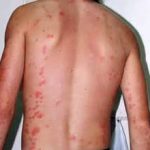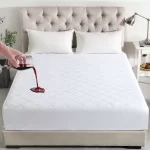If you’ve seen bed bug bites, you know they can be pretty frightening, but don’t worry. Scientific tests have been done with concluding evidence that these blood sucking insects have never been shown to transmit diseases. When bedbugs bite you, they inject a chemical that acts as an anaesthesia; chances are you won’t feel a thing while the bedbugs are feasting on your blood. Everyone’s reaction is different to this chemical injected when a bedbug bites. Some people are very allergic to the chemical, and break out in a rash, or possibly raised welts that might appear and may last as long as a few weeks before completely clearing up. Normally you will only get the raised, itchy welts which should disappear in a few days. There is no real cure for bed bug bites, but if itching is severe, use calamine lotion or anaesthetic creams to treat the itching. If symptoms persist you should seek medical advice.
How to recognise symptoms of bed bug bites
The first sign of bed bugs bites may be red, itchy bites on the skin. Bites may be found in a variety of places on the body. Since bedbugs inject an anaesthetic you won’t feel them bite. Most people do not realise they have been bitten until bite marks appear and can take anywhere from one to several days after the initial bite. The bed bug bite is very similar to that of a mosquito or a flea.
Most often, suspicions are aroused when a person starts to wake up with bites on their body after a night’s sleep. These bites will primarily appear on the parts of the body that are uncovered while you sleep, such as arms and lower legs,which look similar to raised red bumps like those that appear from mosquito bites. There are usually many bites in one area, such as in a grouping or in a line. The bites will be itchy and are easily misdiagnosed as mosquito bites, if you notice bites similar to these, further inspection for bed bugs is needed. If you are bitten by bed bugs, avoid scratching the bites and use an anti-itch cream if the bites start to itch or swell.
Bed bugs are making a comeback worldwide and the accommodation industry is being warned there is no escape. In fact they are more of a problem now than ever before. It’s not just the accommodation industry that is at risk of infestation of bed bugs, but residential homes can face problems from the Cimex lectularius, the common bed bug. The name “bed bug” is derived from the insect’s that preferred the habitat of houses and especially beds or other areas where people sleep. They are attracted to the carbon dioxide we exhale while we are sleeping, thus sending out an invitation to the bed bug to come and feed on our blood.
Mattress encasement protectors for mattresses and bed bases.
If you do suffer at home from a bed bug infestation, you can protect your mattresses and bed bases by fitting specially designed encasement protectors that will prevent bed bugs from entering or escaping. Bed bugs can live up to approx. 1 year without a feed of blood, so even if your beds are infested you can fit an encasement meaning the bed bugs are trapped and will eventually die.
Cover and Protect The Bed Protection Specialists. Sydney, Australia.
For sales or further information please visit our website or call Cover and Protect on 02 931 66654
Cover and Protect The Bed Protection Specialists. Sydney, Australia.
For sales or further information please visit our website or call Cover and Protect on 02 931 66654




